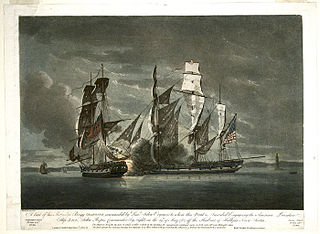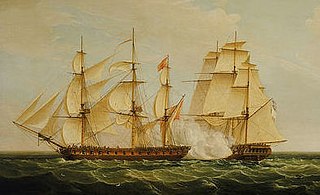HMS Trepassey, often spelled "Trepassy", was a 14-gun brig-sloop of the Royal Navy, formerly the American privateer Wildcat, launched and captured in 1779. The Royal Navy purchased her in 1779. USS Alliance captured Trepassey in 1781. She became the American merchant vessel Defence. In 1782 HMS Jason captured Defense, which the Royal Navy took back into service under her earlier name. The Navy sold her in 1784.
At least three British ship's tender or privateer schooners bore the name Arbuthnot during the American Revolutionary War. They were probably named for Admiral Mariot Arbuthnot, who commanded the British Royal Navy's North American station at that time.
Several ships of the Royal Navy have been named HMS Egmont:
HMS Amphitrite was a 24-gun Porcupine-class sixth-rate post ship of the Royal Navy. She served during the American Revolution primarily in the economic war. On the one hand she protected the trade by capturing or assisting at the capture of a number of privateers, some of which the Royal Navy then took into service. On the other hand, she also captured many American merchant vessels, most of them small. Amphitrite was wrecked early in 1794.

HMS Mercury was a 28-gun Enterprise-class sixth-rate frigate of the Royal Navy. She was built during the American War of Independence and serving during the later years of that conflict. She continued to serve during the years of peace and had an active career during the French Revolutionary Wars and most of the Napoleonic Wars, until being broken up in 1814.

HMS Lowestoffe was a 32-gun fifth-rate frigate of the Royal Navy. Built during the latter part of the Seven Years' War, she went on to see action in the American War of Independence and the French Revolutionary War, and served often in the Caribbean. A young Horatio Nelson served aboard her shortly after passing his lieutenant's examination.

HMS Camilla was a Royal Navy 20-gun Sphinx-class post ship. Camilla was built in Chatham Dockyard to a design by John Williams and was launched in 1776. She served in the American Revolution, the French Revolutionary Wars, and the Napoleonic Wars, before being sold in 1831.

HMS Ferret was a Royal Navy Cruizer-class brig-sloop built by Benjamin Tanner at Dartmouth and launched in 1806, 19 months late. She served on the Jamaica, Halifax, and Leith stations during which time she took three privateers as prizes before she was wrecked in 1813.

The Battle off Halifax took place on 28 May 1782 during the American Revolutionary War. It involved the American privateer Jack and the 14-gun Royal Naval brig HMS Observer off Halifax, Nova Scotia. Captain David Ropes commanded Jack, and Lieutenant John Crymes commanded Observer. The battle was "a long and severe engagement" in which Captain David Ropes was killed.

HMS Aurora was a 28-gun Enterprise-class sixth-rate frigate of the Royal Navy, that saw service during the American and French Revolutionary wars, and the Napoleonic Wars. Designed to carry a complement of 200 men, she was armed with a main battery of twenty-four 9-pound guns.

HMS Medea was a 28-gun Enterprise-class sixth-rate frigate of the Royal Navy. Medea was first commissioned in May 1778 under the command of Captain William Cornwallis. She was sold for breaking up in 1805.
Vice-Admiral Samuel Reeve was an officer of the British Royal Navy who saw service in the American Revolutionary War and the French Revolutionary Wars.

During the late 18th and early 19th centuries, many French privateers and letters of marque bore the name Duguay-Trouin, named for René Duguay-Trouin: René Trouin, Sieur du Gué, French privateer, admiral and Commander in the Order of Saint Louis. Between 1760 and 1810, warships of the Royal Navy captured seven different French privateers all with the name Duguay-Trouin.

HMS Pearl was a fifth-rate, 32-gun British Royal Navy frigate of the Niger-class. Launched at Chatham Dockyard in 1762, she served in British North America until January 1773, when she sailed to England for repairs. Returning to North America in March 1776, to fight in the American Revolutionary War, Pearl escorted the transports which landed troops in Kip's Bay that September. Much of the following year was spent on the Delaware River where she took part in the Battle of Red Bank in October. Towards the end of 1777, Pearl joined Vice-Admiral Richard Howe's fleet in Narragansett Bay and was still there when the French fleet arrived and began an attack on British positions. Both fleets were forced to retire due to bad weather and the action was inconclusive. Pearl was then despatched to keep an eye on the French fleet, which had been driven into Boston.
The French brig Duc de Chartres was built between 1779 and 1780 at Le Havre as a 24-gun privateer. As a privateer she captured one British warship before in 1781 the Royal Navy captured her. The Royal Navy took her into service as HMS Duc de Chartres. She then captured several American privateers and armed merchant vessels, and one French naval corvette in a noteworthy single-ship action. The Navy sold Duc de Chartres in 1784.
HMS Germaine, was the American mercantile vessel Americain that the British Royal Navy captured in 1781 when it captured Saint Eustatius. The British took her into service as HMS Germaine, perpetuating the name of her predecessor captured earlier that year. She captured a number of small prizes in 1782. The Navy sold her in 1784.
HMS Duguay-Trouin was an 18-gun French privateer sloop launched in 1779 at Le Havre. Surprise captured her in 1780 and the British Royal Navy took her into service under her existing name. It sold Duguay-Trouin on 30 October 1783. She then became the West Indiaman Christopher. She captured several French merchant vessels. Later she became a Liverpool-based slave ship, making five voyages in the triangular trade in enslaved people. She was lost at Charleston in September 1804 in a hurricane.

Captain David Ropes was a notable American Privateer from Salem, Massachusetts who fought in numerous naval battles during the American Revolution. He was taken prisoner twice during the war and then killed in the Battle off Halifax (1782).
HMS Otter was the French merchantman Glanure, which the Royal Navy (RN) captured early in 1778. The Royal Navy took her into service as the sloop HMS Otter and she served in the American theatre. The Navy sold her in 1783. She became a merchantman and then a slave ship in the triangular trade in enslaved people. She made two complete voyages bringing captives to Jamaica. The French captured her in December 1795 as she was on her way to deliver her third cargo of captives.
Mentor was launched in 1778 at Chester as a West Indiaman. She captured three vessels, including a valuable East Indiaman belonging to the French East India Company. She had an inconclusive single ship action with a French warship in 1779. She was wrecked in 1782.










